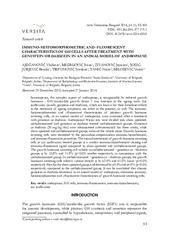Приказ основних података о документу
Immuno-histomorphometric and -fluorescent characteristics of GH cells after treatment with genistein or daidzein in an animal model of andropause
| dc.creator | Ajdžanović, Vladimir | |
| dc.creator | Jarić, Ivana | |
| dc.creator | Živanović, Jasmina | |
| dc.creator | Šošić-Jurjević, Branka | |
| dc.creator | Trifunović, Svetlana | |
| dc.creator | Tanić, Nasta | |
| dc.creator | Milošević, Verica | |
| dc.date.accessioned | 2016-05-23T11:00:44Z | |
| dc.date.available | 2016-05-23T11:00:44Z | |
| dc.date.issued | 2014 | |
| dc.identifier.issn | 1820-7448 | |
| dc.identifier.uri | https://radar.ibiss.bg.ac.rs/handle/123456789/2279 | |
| dc.description.abstract | Somatopause, the complex aspect of andropause, is recognizable by reduced growth hormone - GH/insulin-like growth factor 1 axis function in the ageing male. Soy isoflavones (usually genistein and daidzein), which are known for their beneficial effects in the treatment of ageing symptoms, are active in the pituitary, as well. The iromuno-histomorphometric and fluorescent characteristics of pituitary growth hormone secreting cells, in an animal model of andropause, were examined after a treatment with genistein or daidzein. Andropausal Wistar rats were divided into sham operated, orchidectomized and genistein or daidzein treated orchidectomized groups. Genistein or daidzein (30 mg/kg/day) were administered subcutaneously for three weeks, while sham operated and orchidectomized groups received the vehicle alone. Growth hormone secreting cells were identified by the percoxidase-antiperoxidase immuno-histochemical, and inmuno-fluorescent procedure. The main characteristic of growth hormone secreting cells in soy isoflavones treated groups is a weaker immuno-histochemical staining and immuno fluorescent signal compared to sham operated and orchidectomized groups. The growth hormone secreting cell volume in orchidectomized +genistein or +daidzein groups is by 13.8\% and 11.9\% (p<0.05) smaller respectively, in comparison with the orchidectomized group. In orchidectomized +genistein or +daidzein groups, the growth hormone secreting cells relative volume density is by 62.5\% and 61.0\% lower (p<0.05) respectively than for the sham operated group, and decreased by 65.4\% and 64.0\% (p<0.05) respectively, compared to the orchidectomized group. It can be concluded that chronic genistein or daidzein treatment, in an animal model of andropause, attenuates immuno-histomorphometric and fluorescent characteristics of growth hormone secreting cells. | en |
| dc.description.sponsorship | Ministry of Education, Science and Technological Development of the Republic of Serbia {[}173009] | |
| dc.language | English | |
| dc.publisher | Belgrade: Faculty of Veterinary Medicine, University of Belgrade | |
| dc.rights | openAccess | |
| dc.rights.uri | https://creativecommons.org/licenses/by/4.0/ | |
| dc.source | Acta Veterinaria-Beograd | |
| dc.subject | andropause | |
| dc.subject | immuno-fluorescence | |
| dc.subject | immuno-histochemistry | |
| dc.subject | soy isoflavones | |
| dc.title | Immuno-histomorphometric and -fluorescent characteristics of GH cells after treatment with genistein or daidzein in an animal model of andropause | en |
| dc.type | article | |
| dc.rights.license | BY | |
| dcterms.abstract | Зивановиц, Јасмина; Трифуновиц, Светлана; Aјджановић, Владимир; Таниц, Наста; Шошић-Јурјевић, Бранка Т.; Милосевиц, Верица; Медиговиц, Ивана; | |
| dc.rights.holder | © 2014 by the Faculty of Veterinary Medicine, University of Belgrade | |
| dc.citation.issue | 1 | |
| dc.citation.volume | 64 | |
| dc.identifier.doi | 10.2478/acve-2014-0010 | |
| dc.identifier.scopus | 2-s2.0-84902456818 | |
| dc.identifier.wos | 000341341000010 | |
| dc.citation.spage | 93 | |
| dc.citation.epage | 104 | |
| dc.type.version | publishedVersion | en |
| dc.identifier.fulltext | https://radar.ibiss.bg.ac.rs/bitstream/id/14276/2014-Ajdzanovic-et-al.pdf |

